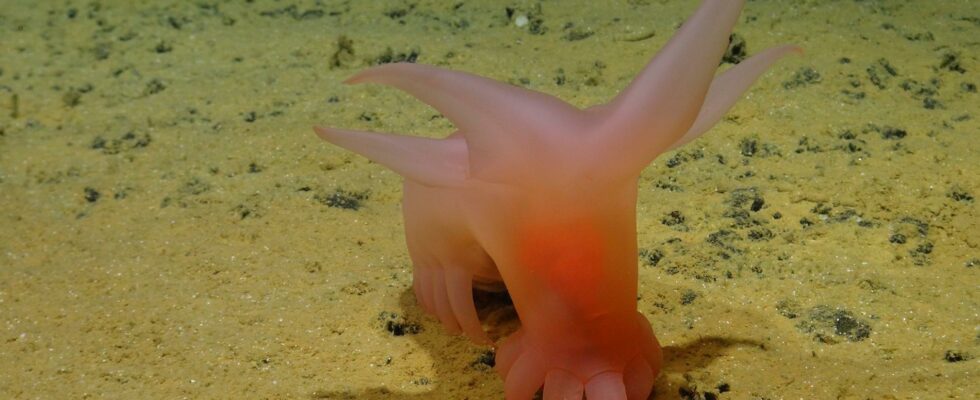unsaveSave
The porpoise discovered during the expedition was named for its pink color and small feet, and is between 20 and 30 centimeters long.
1 / 5Photo: Press image Smartex/Nhm/Noc
A “Barbie pig” and a creature that can be 15,000 years old. Scientists recently found several mysterious species – in the middle of an area subject to large-scale offshore mining.
– We need to know more about animal life in order to protect it, says researcher Thomas Dahlgren, who participated in the expedition.
When the bright pink porpoise was seen wandering around on the seabed, several thousand meters down, the screens in the research vessel’s control room erupted in joy.
– That we find new species in the deep sea is not unusual. But when you discover a creature like this, you get excited, says Thomas Dahlgren, researcher in marine ecology at the University of Gothenburg and the research center Norce in Bergen.
He took part in the 45-day expedition this spring in the Pacific between Mexico and Hawaii led by British scientists. The aim was to explore life between 3,500 and 5,500 meters deep – which is still largely a mystery.
Record long life
In addition to the pink creature that the British call “Barbie sea pig”, the researchers picked up a transparent sea cucumber and a funnel-shaped animal with the longest known lifespan on Earth, 15,000 years – and an estimated thousands of other species.
Now work is underway to identify them, but it is certain that many of them will be surprises. Nine out of ten species that are taken up from the deep sea are usually unknown to science, says Thomas Dahlgren.
– Despite the fact that these deep-sea plains are the most common environment on Earth, they cover more than half of the Earth’s surface, there has been little interest in exploring them.
Until now. Countries and companies are now turning their eyes to the seabed in search of rare metals for solar cells, batteries and other green technology. Therefore, it is urgent for scientists to understand what lives in the depths – before it is too late. Several companies are in the starting pits, not least for mining in the so-called Clarion-Clipperton zone where the expedition last spring took place.
Potato-sized lumps
What the mining companies want to pick up are potato-sized lumps containing metals such as cobalt, nickel, copper and manganese, which are highly sought after.
Both scientists and environmental organizations warn that deep-sea mining would damage ecosystems and species richness. The question is how much.
Before the international seabed authority ISA can possibly give the mining the go-ahead, it is important to understand more. Last year, a study came out that showed that almost 5,000 new species were found in the Clarion-Clipperton zone.
Today, one third of the area is protected. But whether it is enough to prevent the extinction of species in case of possible mining is unclear according to the researchers.
Substances for medicines
In addition to the fact that the species can be important pawns in the ocean’s ecosystem, they could be useful for humanity, for example for future medicines, emphasizes Thomas Dahlgren.
– There is so much left to discover and research.
During the expedition last spring, for example, sea cucumbers were found completely free of growth, which could indicate substances with antibiotic properties.
– It is on our “to do-list” to investigate further, says Dahlgren.
Today there is a temporary ban on deep-sea mining, but this can be changed with a set of regulations that ISA is now developing.
At the same time, there are fears that the mining will already begin in the next few years before the consequences are fully understood.
– That is why it is important that the regulations are based on knowledge that is produced about the effects of mining technology on the environment, and about species and ecosystems in the deep sea, says Thomas Dahlgren.
There are also plans for offshore mining in our immediate area. In Norway, the government has agreed to open the country’s seabeds to the possibility of exploitation, if the negative environmental effects are limited. This despite harsh international criticism from, among others, the EU Parliament.
Extraction in the Baltic Sea
In Sweden, too, there are plans to suck up nodules containing metals from the seabed, even if it is not about deep-sea mining. The company Scandinavian Ocean Minerals has exploration permits for two areas in the Gulf of Bothnia, and researchers are mapping the consequences.
But Dahlgren sees it as out of the question to extract metals in the Baltic Sea, which is so badly affected by eutrophication, bottom death and overfishing.
– As a biologist, I see no chance in the world of getting permission to do it in seabeds that are already full of environmental toxins, and given that the Baltic Sea is already struggling.
FACT Treasure hunting in the depths of the sea
The deep sea is believed to be the largest ecosystem on Earth, but is the least explored.
There are also areas rich in metals such as nickel, copper, manganese and cobalt. Extraction could be done in three ways:
Lumps, called nodules, containing various metals are sucked up from the seabed, sometimes at a depth of 5,000 meters, and taken up via large pipes.
Crusts that are found on slopes and mountains in the sea and that are rich in cobalt are “scraped” off.
Mineral-rich sediments found at hot springs along oceanic spreading ridges are “scraped” up from the bottom.
Source: UI, Thomas Dahlgren.
Read more
